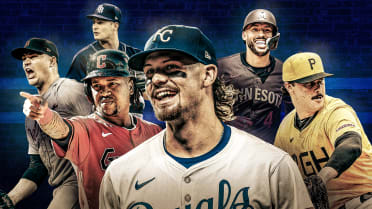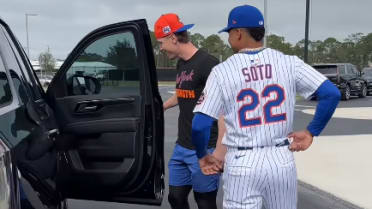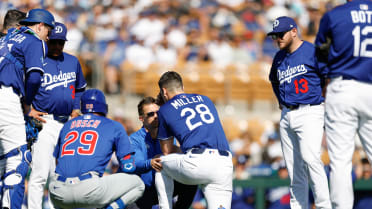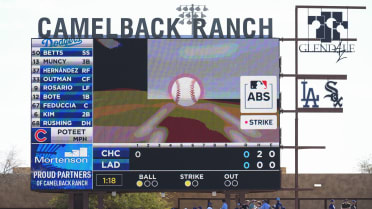6 takeaways from Twins' Summer Camp
MINNEAPOLIS -- In a way, there wasn't much left to learn about the 2020 Twins in Summer Camp that we hadn't already found out during Spring Training in Fort Myers, Fla., in February and March.
These three weeks were more a chance to see firsthand that Byron Buxton's left shoulder had fully healed and that Rich Hill can still throw a baseball at his customary elite level following his offseason left elbow surgery. In many ways, more of the questions surrounding this return-to-play period revolved around whether the Twins would make it through without any significant degree of roster attrition -- whether due to COVID-19 or otherwise.
Those injury considerations were certainly significant, and it changed the roster picture to know that both Buxton and Hill arrived in camp in stellar playing condition. We've learned a few other things along the way, too. So because the Twins have an off-day on Thursday and Opening Day in Chicago looms just more than a week away, let's take a look at six things we've learned about Minnesota in Summer Camp.
1. The team is (mostly) in good health and physical condition
Up until Buxton sustained a left mid-foot sprain while chasing a fly ball during Monday's intrasquad game, the Twins had a clean camp on the injury front. Aside from Buxton and the three players who remain sidelined due to COVID-19 (Willians Astudillo, Nick Gordon and Wilfredo Tovar), the club hasn't seen any significant baseball-related injuries throughout the hiatus or the two weeks of camp.
That's particularly significant because several players have acknowledged that this season could be determined by which teams stay the most healthy. A player being sidelined by a minor strain for five to 10 games wouldn't be a huge deal during a normal year, but in a 60-game regular season, that's a considerable chunk.
That's likely part of the reason why the Twins eased into extended action during Summer Camp, so they could avoid the soft-tissue injuries that might pop up in a short ramp-up period. While some other teams have played simulated games throughout camp, Minnesota didn't formally break into two teams and hold "real" game action until Wednesday.
The Twins arrived in camp in great condition and seem to have responded well to the ramp-up. And with optimistic outlooks for both Buxton and Miguel Sanó, this team could still be in good condition come next Friday -- much better condition than they would have been in for a March 26 Opening Day, anyway.
2. Donaldson's energy and edge are already apparent
It's certainly odd for hitters and pitchers from the same team to square off in intrasquad matchups without fans in the stands, but these circumstances allow for personalities to shine through more than they would in Spring Training. That's been most evident at the hot corner, where Josh Donaldson's good-natured-yet-competitive personality has become fully apparent.
Donaldson does plenty of jawing with his teammates when he's in the batter's box, whether he's shouting at the pitcher in joking triumph after he beats the shift for a single or yelling at the (robot) umpire for what he perceived to be an incorrect strike call. At one point, after hitting a ball in the vicinity of the right-field foul pole that his teammates deemed to be foul, Donaldson rounded the bases and did an energetic home-run celebration anyway.
"I’m not much of a trash talker," right-hander Randy Dobnak said. "I kind of just let whatever happens out on the field just happen. I don't really think I'm in a position to have a lot of trash talking going yet. But yeah, Donaldson, he gives it to you. That part of the game is really awesome, just for everybody involved, the players and the fans hearing it and stuff like that. It sparks the fire and the competitiveness and just makes it fun."
Donaldson balances all that yelling and dancing with a firmer hand when needed, too, like when he appeared to ask Eddie Rosario to run a bit harder after the Twins left fielder didn't score from second base when Donaldson was caught in a rundown. Minnesota's new $92 million man only plays the game at one speed -- and that's the kind of fun but strict leadership the club will hope to continue seeing from him over the four years of his contract.
3. The pitching depth is in great shape
It may have raised some eyebrows when Twins pitching coach Wes Johnson said that the club would stretch out 10 starters in Major League camp (with two prospects and Michael Pineda waiting in the wings at the alternate training site in St. Paul). That's not just for show. That's just how deep this pitching staff is, and they've mostly looked the part throughout Summer Camp.
The five projected members of the starting rotation -- José Berríos, Jake Odorizzi, Kenta Maeda, Hill and Homer Bailey -- have fared well in intrasquad games against their teammates (and keep in mind, this is the Bomba Squad we're talking about). Dobnak has looked his usual efficient self and drew some ugly swings from good hitters early in camp. Devin Smeltzer has had time to integrate his new slider into his arsenal, while Lewis Thorpe's polished pitch mix has also drawn plenty of swings and misses.
Don't forget Jhoulys Chacín, who has looked efficient, or Sean Poppen, who has struggled with control but still has the lively raw stuff that could play up with more refinement. The stable is deep here, and both manager Rocco Baldelli and Johnson have noted that most of the starting pitchers showed up at or better than expected in terms of physical condition. That's a good sign for either a sprint or a marathon.
4. Hill could be an X-factor
Hill's recovery went smooth enough that he not only arrived in camp ready to pitch, but he may have been physically ahead of many of his rotation-mates, despite being unable to participate in games during Spring Training as he recovered from a primary repair procedure on his pitching elbow.
The veteran left-hander was stretched out to bullpen sessions of 80 pitches before his arrival in Minneapolis, and while many of the other starters threw two- or three-inning stints in their first batting-practice sessions of camp, Hill threw four frames in his summer debut. The next time around, everyone else in the rotation was held to around four innings. As for Hill? He was so efficient that he pitched the equivalent of more than five innings across an intrasquad game and batting practice.
The ugly swings that you'd expect to see induced by Hill's fastball-curveball combination have been prevalent throughout camp, which is a great sign for the Twins, who acquired Hill with the hope that he could emulate his 3.00 ERA and 10.6 strikeouts-per-nine-innings rate from the past four seasons. For now, there's little reason to believe he won't.
5. Jeffers' MLB arrival could be soon
Ryan Jeffers has played only 24 games above the Class A Advanced level, but you wouldn't know that from watching the way the Twins have handled their prized catching prospect in camp. Jeffers, Minnesota's No. 6 prospect per MLB Pipeline, has been right there alongside Mitch Garver and Alex Avila every step of the way in camp, catching the Major League pitchers, taking batting practice with the roster players and seeing action in intrasquad games.
That's significant because the Twins could have turned to Tomás Telis or Juan Graterol -- a pair of veterans with MLB experience -- as their catching depth in camp. Instead, Jeffers appears to be the next man up, and Minnesota had already made no secret of its affinity for the former second-round Draft selection over the past year. Jeffers' physique is MLB-ready, the Twins are high on his defensive ability and his big power was on display when he took Tyler Clippard deep for a game-tying homer on Wednesday.
Jeffers might have been on track to make his MLB debut in late 2020 in a normal season. With Astudillo still out due to COVID-19, Jeffers' opportunity might be closer than many expected.
6. Expect to see other prospects -- just not the ones you'd think
Much of the prospect buzz around the Twins' 60-man player pool surrounded the organization's "big three" of Royce Lewis (No. 1), Alex Kirilloff (No. 2) and Trevor Larnach (No. 3), all of whom are working out at the alternate training site at CHS Field in St. Paul. At this point, though, it would come as a surprise if Minnesota accelerated any of their development timelines to push them into meaningful MLB action during the 2020 regular season, due also to the roster considerations involved with finding any of them a more permanent spot on the 40-man roster.
Instead, the prospects who could see action this season would be those who are either already on the doorstep of the Majors (mainly meaning No. 12 prospect Brent Rooker) or already on the 40-man roster (referring to No. 17 prospect Gordon and No. 18 Travis Blankenhorn).
With Gordon sidelined due to COVID-19, Blankenhorn appears to be in position to earn some playing time as infield and outfield depth, as his defensive versatility across second base, third base and left field couples with a left-handed bat with some pop and speed. Rooker has gotten most of the backup reps at first base behind Marwin González in the absence of Sanó, though his path to the roster is slightly more complicated because he's not already on the 40-man roster.
Do-Hyoung Park covers the Twins for MLB.com.




